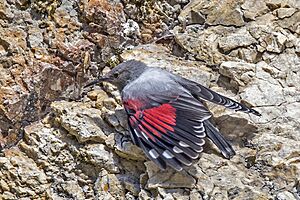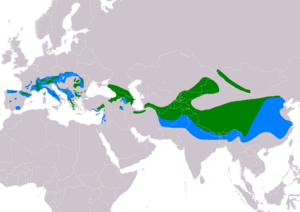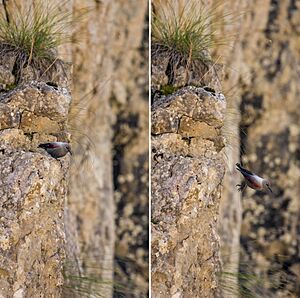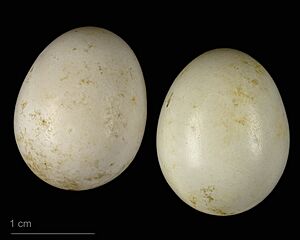Wallcreeper facts for kids
Quick facts for kids Wallcreeper |
|
|---|---|
 |
|
| Female in the Piatra Craiului Mountains, Transylvania, Romania | |
| Conservation status | |
| Scientific classification | |
| Genus: |
Tichodroma
|
| Species: |
muraria
|
 |
|
| Range of T. muraria (Compiled by: BirdLife International and Handbook of the Birds of the World (2019) 2019.) Resident Non-breeding | |
| Synonyms | |
|
|
The wallcreeper (Tichodroma muraria) is a small passerine bird that lives in the high mountains. You can find it across the Palearctic region, from southern Europe all the way to central China. It's the only living member of its group, called Tichodroma, and its own special bird family, Tichodromidae.
Contents
About the Wallcreeper
Scientists have discussed where the wallcreeper fits in the bird family tree. It was first grouped with treecreepers. Now, many experts place it in its own unique family, Tichodromadidae. Others put it as a special subgroup within the nuthatch family, Sittidae. Either way, it's very closely related to nuthatches. The name Tichodroma comes from Ancient Greek words meaning "wall" and "runner." The name muraria means "of walls." Sometimes, this bird is also called the red-winged wall creeper because of its bright colors.
Wallcreeper Types
There are two main types, or subspecies, of wallcreeper:
- European wallcreeper (T. m. muraria): This type lives from southern and eastern Europe to the Caucasus mountains and western Iran.
- T. m. nepalensis: This type is found from Kazakhstan and Turkmenistan to eastern China.
What Does a Wallcreeper Look Like?
The wallcreeper is a medium-sized bird, about 15.5 to 17 centimeters (6 to 6.7 inches) long. It weighs about 17 to 19 grams (0.6 to 0.7 ounces). Its body feathers are mostly blue-grey. Its flight and tail feathers are darker. The most amazing part of its look is its bright crimson (red) wings! This bright color is mostly hidden when its wings are folded. But when it spreads its wings, you can see the stunning red on many of its feathers. The T. m. nepalensis type is a bit darker than the European type.
Wallcreeper Sounds
Wallcreepers are usually quiet birds. However, both male and female wallcreepers can sing. Females usually sing to protect their feeding areas in winter. Their song is a high-pitched, long whistle. The notes go up and down. During the time they raise their young, the male sings while sitting or climbing on rocks.
Where Wallcreepers Live
Wallcreepers are birds of high mountains. They build their nests at heights between 1,000 and 3,000 meters (3,300 and 9,800 feet). They usually stay in the same area all year. But in winter, they move to lower places. You might find them on buildings or in old quarries then. For example, in France, they often spend winter on old cathedrals and bridges. Some have even traveled far, like to England and the Netherlands. One wallcreeper spent two winters in a row at a university in Amsterdam! They live all year in much of the Himalayas, including India, Nepal, Bhutan, and parts of Tibet. They also visit Bangladesh in winter.
Wallcreeper Behavior and Life
These birds can be quite friendly, but they are often hard to spot on mountain cliffs. Even though they might seem tame, they will still try to hide if they know you are watching them. They might even take a long way around to get to their nest if they feel watched.
Wallcreepers are very protective of their space. Pairs strongly defend their nesting areas in summer. In winter, wallcreepers live alone. Males and females each protect their own feeding areas. These feeding areas can be a large quarry or a series of smaller rock faces. Wallcreepers might fly some distance from where they sleep to where they eat. They often return to the same winter feeding spots year after year.
Wallcreeper Reproduction
The female wallcreeper builds a cup-shaped nest using grass and moss. She hides it deep inside a crack in a rock, a hole, or a cave. The nest is lined with soft materials like feathers or wool. It usually has two entrances. The female typically lays 4 or 5 eggs, though sometimes as few as three. The eggs are white, about 21 millimeters (0.8 inches) long, and have a few black or reddish-brown speckles.
Once all the eggs are laid, the female sits on them to keep them warm for 19 to 20 days until they hatch. While she is incubating, her mate regularly brings her food. When the baby birds hatch, they are altricial. This means they are born blind, without feathers, and completely helpless. Both parents feed the nestlings for about 28 to 30 days until the young birds are ready to fly. Each pair usually raises only one group of babies per year.
What Wallcreepers Eat
The wallcreeper is an insectivore, which means it eats insects. It mostly finds land invertebrates, like insects and spiders, by picking them off rock faces. Sometimes, it will also fly out from a rock perch to catch flying insects. When a wallcreeper is looking for food, it moves across a cliff face with short flights and quick hops. It often keeps its wings partly spread as it moves.






